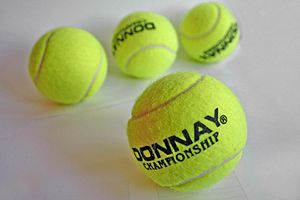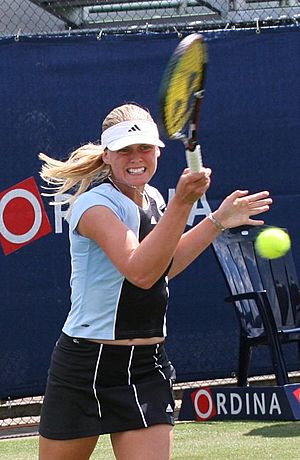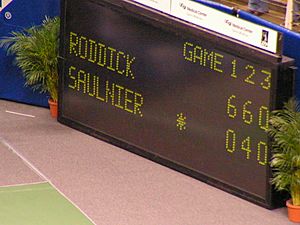Tennis facts for kids
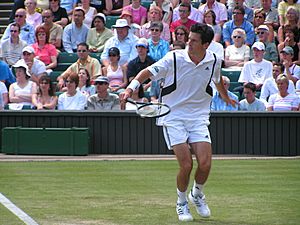
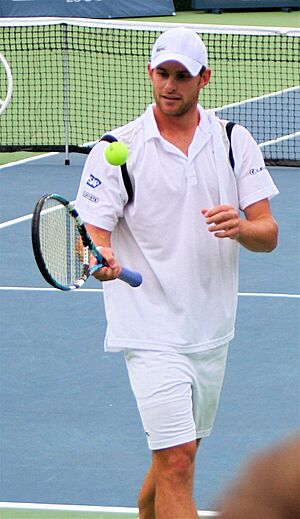
Tennis is a fun sport played with a special rubber ball, a tennis racket, and a court. Every year on September 23, people celebrate "Tennis Day"! The sport's full name is actually "lawn tennis".
Long ago, around the 11th century, people in France played a game similar to tennis using their hands. They called it “Jeu de Paume”. Later, in the 15th century, players started using rackets. That's when it became known as “tennis”. It quickly grew popular in England and France. Even King Henry III of France was a big fan! This older version of the game is still played today, but it's called "real tennis" (meaning "royal" tennis). The "lawn tennis" we know today, played on grass courts, was invented in England in the mid-1800s. From there, it spread all over the world. Most people just call it "tennis" for short.
Contents
How Tennis Matches Work
Tennis can be played on different types of courts, like grass, clay, or hard courts. The main goal is to hit the ball over the net and into your opponent’s side of the court. If your opponent can't hit the ball back, you win a point!
Tennis can be played with two people or four people. When two people play, it's called “singles”. When four people play (two teams of two), it's called “doubles”. In doubles, there are extra areas on the sides of the court called "alleys" that are part of the playing area.
Scoring in Tennis
A tennis match is made up of sets. Each set has several games, and each game has points. The points are counted in a special way:
- Love (which means 0)
- Fifteen (15)
- Thirty (30)
- Forty (40)
If both players reach forty points, the score is called deuce. From deuce, a player needs to win two more points in a row to win the game.
To win a set, a player needs to win six games. However, they must win by at least two games. So, if the score is 5-5 in games, a player needs to win 7-5 or 8-6 to take the set. If the game score reaches 6-6, a special "tiebreaker" game is played. In a tiebreaker, points are counted as "one," "two," and so on. The first player to reach at least seven points and be ahead by two points wins the tiebreaker and the set.
In a match, if it's a three-set match, the first player to win two sets is the winner.
The Tennis Court
Tennis is played on a flat, rectangular area. The court is 78 feet (about 23.77 meters) long. For singles matches, it's 27 feet (about 8.23 meters) wide. For doubles matches, it's wider at 36 feet (about 10.97 meters). Players also need extra space around the court to run and hit balls that go wide.
A net stretches across the middle of the court, dividing it into two equal halves. This net is held up by a cord or metal cable. The net is about 3 feet 6 inches (1.07 meters) high at the posts and 3 feet (0.91 meters) high in the center.
Types of Court Surfaces
One cool thing about tennis is that it's played on different surfaces! The most common types are grass, clay, and hardcourts. Hard courts are usually made of concrete or asphalt with an acrylic top layer. Sometimes, indoor courts use carpet. In the past, wooden floors were also used. You might also find courts made of Artificial turf.
Court Lines Explained
The lines on the court are very important for knowing if a ball is in or out.
- The lines at the very back of the court are called the baselines.
- The lines in the middle of each half of the court are the service lines.
- The short mark in the center of each baseline is the center mark.
- The outermost lines running along the length of the court are the doubles sidelines. These are the boundaries for doubles matches.
- The lines just inside the doubles sidelines are the singles sidelines. These are the boundaries for singles matches.
- The area between a doubles sideline and the nearest singles sideline is called the doubles alley. This area is only in play during doubles matches.
- The line that crosses the center of a player's side of the court is the center service line. This line divides the service area into two boxes.
- The two boxes created by the service line and center service line are called the service boxes. When a player serves, the ball must land inside one of these boxes on the opponent's side.
A ball is only "out" if no part of it touches the line or the area inside the lines on its first bounce. All lines on the court are usually between 1 and 2 inches (2.5 to 5 centimeters) wide. The baseline can be up to 4 inches (10 centimeters) wide, but it's often the same width as the others.
Soft Tennis
There's also a different version of tennis called soft tennis. It's played with different rackets, balls, and rules compared to regular tennis. Soft tennis is very popular in Japan, with thousands of people playing it. Tennis is a widely enjoyed sport that many people love to watch!
Tennis Shots and Strokes
In tennis, there are many different ways to hit the ball. These are called "shots" and "strokes." A stroke describes how your body moves to hit the ball, while a shot describes how the ball is hit.
- Strokes
- The backhand is a stroke where you swing the racquet across your body. If you're right-handed, you start with the racket on your left side, swing it across your body, and hit the ball. It can be done with one hand or two hands.
- The forehand is the opposite of the backhand. For a right-handed player, the stroke starts on the right side of the body and moves across to the left side. Most players hit a forehand with one hand (usually their dominant hand).
- Shots
- A serve (or service) is the shot that starts each point. Players usually toss the ball into the air and hit it over the net. Serves can be done underhand or overhead, but the overhead serve is the most common. The serve must be hit from behind the baseline (the line at the back of the court). It needs to land inside the service box that is diagonal to where the server is standing.
- A volley is a shot hit before the ball bounces on the ground. Players usually hit volleys when they are close to the net.
- A drop shot is a very soft hit that makes the ball just barely clear the net and land very close to it. The goal is for the opponent not to be able to run fast enough to reach it.
- A lob is a shot where you hit the ball high into the air. The idea is to make the ball go over your opponent's head and land deep in their court, usually between the baseline and the service line.
The Four Grand Slams
Tennis is a global sport, and it's even played at the Olympics! There are also four very big tournaments that are super important in tennis. They are called the Grand Slam events:
- Australian Open (played in January)
- French Open (played in May-June)
- Wimbledon (played in June-July)
- US Open (played in August-September)
If a player wins all four Grand Slams in the same year, it's called a "Calendar Slam." These tournaments are the most important ones each year because they offer the most world ranking points, have a lot of history, offer big prize money, and get a lot of public attention.
Images for kids
-
Augurio Perera's house in Edgbaston, Birmingham, England, where he and Harry Gem first played modern lawn tennis
-
An umpire explaining rules to two players
-
Andy Murray hitting a two-handed backhand
-
A tennis match at Centre Court in Wimbledon in 2007
-
Margaret Court hitting a backhand
-
Serena Williams, July 2008
See also
 In Spanish: Tenis para niños
In Spanish: Tenis para niños


